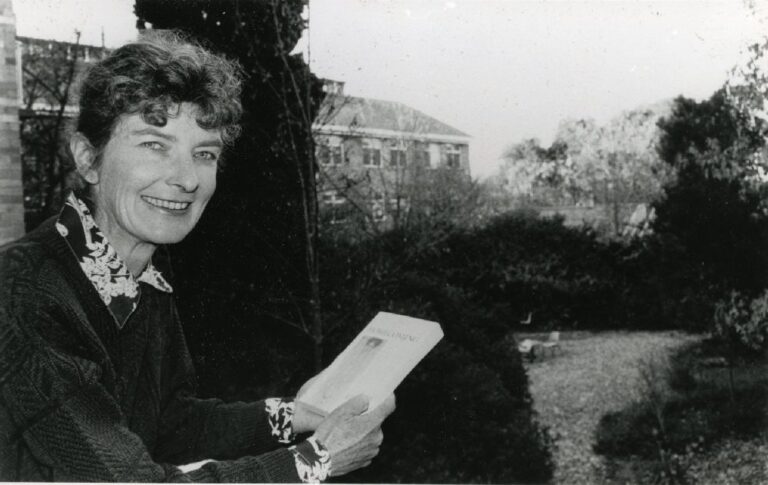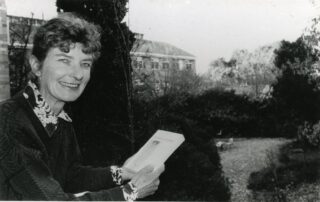- Entry type: Person
- Entry ID: AWE4874
Serjeantson, Susan Wyber
(1946 – )
- Born 14 November 1946, Riverstone, New South Wales, Australia
- Occupation Geneticist
Summary
Professor Sue Serjeantson had a distinguished career as a geneticist in the John Curtin School of Medical Research at the Australian National University. Her research concerned the inherited susceptibility to disease and the human immune response to organ transplantation. She was the first woman to hold the position of Deputy Vice-Chancellor and Director of the Institute of Advanced Studies at the University.
Details
Sue Wyber was born in the Sydney suburb of Riverstone in 1946 to Nancye and Robert Wyber. Her father was an engineer and Director of the Royal Australian Navy Research Laboratory in Edgecliff, Sydney. She matriculated from Caringbah High School in 1963 and was both Dux and School Captain. In 1967, she completed a Bachelor of Science degree with Honours from the University of New South Wales on an Australian Wool Board scholarship. In 1968 she took up a Postgraduate Research Scholarship, undertaking research in the School of Human Genetics, Faculty of Medicine, University of New South Wales, then transferring to the Department of Genetics, University of Hawaii on an East-West Center Scholarship. Her research involved data collection in Papua New Guinea for her thesis on the population genetic structure of the Kiunga sub-district of Papua New Guinea. She was awarded the degree of Doctor of Philosophy and married John Charles Serjeantson in 1970. She held positions of Lecturer in Science at the Madang Teachers’ College in 1971 and Lecturer at the Papua New Guinea Institute of Medical Research from 1972.
In 1976 she was appointed a Research Fellow in the Department of Human Biology at the John Curtin School of Medical Research at the Australian National University, continuing her research in Papua New Guinea which concerned inherited susceptibility to disease, and managing a tissue-typing laboratory. A contract position as Fellow awarded in September 1980 was converted to a permanent appointment in 1984. Her son was born in 1985. She was promoted to Senior Fellow in July 1986 in what was then called the Department of Human Genetics. She was appointed head of the department in 1987, then ‘Group leader’ of Human Genetics after a restructuring of the School. On 14 October 1988 she was formally appointed Professor of Human Genetics.
Her research concerned the genetic basis of diseases such as juvenile and mature-onset diabetes, systemic lupus erythematosus and leprosy. Her work on human leucocyte antigens advanced understanding of the human immune response to organ transplants and improved the matching of bone marrow donors and recipients. She published prolifically in international journals and regularly attended overseas conferences, as an invited speaker, in Europe, Japan and the United States. She was successful in securing grant funding for her research from the US National Institutes of Health, the National Health and Medical Research Council, the Anti-cancer Council of Victoria, the National MS Society of Australia and Juvenile Diabetes Foundation.
She served on a number of University committees including the Board of the Institute of Advanced Studies from 1987 to 1989, the John Curtin School of Medical Research Faculty Board as an elected representative 1988-1990 and 1992-1994, and the ANU Re-entry Fellowships for Women Committee in 1988.
She was awarded a Clunies-Ross National Science and Technology Award in 1992 and the Ruth Sanger Medal by the Australasian Society of Blood Transfusion also in 1992. She was appointed Regional Coordinator for South-East Asia and Oceania for the Stanford University’s Human Genome Diversity Project in 1993.
She was acting Director of the John Curtin School of Medical Research from April till September 1993, then in January 1994 was appointed Director of the Institute of Advanced Studies and Deputy Vice-Chancellor, and was an ex-officio member of the Board of the Institute of Advanced Studies and the Board of the Faculties. She retained her academic standing as a Visiting Fellow at the John Curtin School of Medical Research. She was a Director of ANUTECH Pty Ltd from 1994 till 1997 and a member of the Commonwealth government’s Genetic Manipulation Advisory Committee from 1994 to 1996.
As Deputy Vice-Chancellor she was responsible for research at the University: the heads of the Research Schools and Centres reported to her as well as the Director of Computing Services and other areas. She resigned from her position in 1997 but continued as a Visiting Fellow at the John Curtin School of Medical Research until the end of 2001 and was from 1999 to 2001 the President of the Federation of Australian Science and Technological Societies. In this role she spoke at the Women Achieving in Science Conference which was held at RMIT University in November 1999 on ‘Why are there so few women in science?’. She was made an Officer of the Order of Australia in 2000, and from 2001 to 2008 was Executive Secretary of the Australian Academy of Science. She was made ‘Officer dans l’Ordre des Palmes Académiques’ by the French government in 2009.
Digital resources
Published resources
-
Resource Section
- Biographical entry Serjeantson, Susan Wyber (1946 - ), Walker, Rosanne, 2004, http://www.eoas.info/biogs/P002744b.htm
-
Journal Article
- Why are there so few women in science?, Serjeantson, S, 2000, http://www.wisenet-australia.org/issue54/sergeant.htm
-
Report
- Annual Report 2008 - 09, 1 April 2008 - 31 March 2009, 2009, http://science.org.au/reports/annual-report-08-09/AnnualReport2008-09.pdf
-
Book Section
- International Activities, 2010, http://www.science.org.au/reports/annual-report-09-10/2010anrep-9.pdf
-
Site Exhibition
- From Lady Denman to Katy Gallagher: A Century of Women's Contributions to Canberra, Australian Women's Archives Project, 2013, http://www.womenaustralia.info/exhib/ldkg
-
Resource
- Trove: Serjeantson, Susan Wyber (19461114-), http://nla.gov.au/nla.party-1475588
